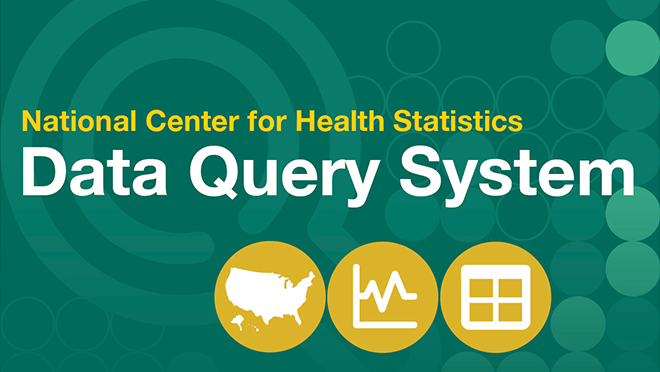At a glance
- The National Center for Health Statistics Data Query System features estimated death rates for cancer, drug overdose, heart disease, and suicide.
- Drug overdose death rates are available for selected types of drugs, like opioids and heroin.
- These estimates are based on data from the National Vital Statistics System.

Cancer deaths
Cancer is a disease in which some of the body's cells grow uncontrollably. These cells can spread to other parts of the body, damage organ systems, and lead to death.
Cancer deaths
Sources
Health, United States publishes data from the National Vital Statistics System (NVSS).
Preliminary Data
DQS includes final data from NVSS. More recent preliminary data for this topic are available through the NVSS Vital Statistics Rapid Release and CDC WONDER Provisional Mortality Statistics.
Drug overdose deaths
Death from drug overdose occurs when a person takes enough of a drug or medicine to cause death.
Drug overdose deaths
Get statistics from the NCHS Data Query System.
- All drug overdose deaths
- Drug overdose deaths involving any opioid
- Drug overdose deaths involving heroin
- Drug overdose deaths involving natural and semisynthetic opioids
- Drug overdose deaths involving methadone
- Drug overdose deaths involving synthetic opioids other than methadone
Sources
Health, United States publishes final data from the National Vital Statistics System (NVSS).
Preliminary Data
DQS includes final data from NVSS. More recent preliminary data for this topic are available through the NVSS Vital Statistics Rapid Release and CDC WONDER Provisional Mortality Statistics.
Fetal, late fetal, and perinatal death rates
Fetal death is the intrauterine death of a fetus before delivery from the mother.
- Fetal death rates are calculated as the number of fetal deaths at 20 weeks of gestation or more divided by the number of live births and fetal deaths.
- Late fetal death rates are the number of fetal deaths at 28 weeks of gestation or more divided by the number of live births and late fetal deaths.
- Perinatal death rates are the number of late fetal deaths and infant deaths within 7 days of birth divided by the number of live births and late fetal deaths.
Fetal, late fetal, and perinatal death rates
Get statistics from the NCHS Data Query System.
Sources
Health, United States publishes data from the National Vital Statistics System.
Heart disease deaths
The term "heart disease" refers to several types of heart conditions. The most common type of heart disease in the United States is coronary artery disease. This affects blood flow to the heart, which can be fatal.
Heart disease deaths
Sources
Health, United States publishes data from the National Vital Statistics System (NVSS).
Preliminary Data
DQS includes final data from NVSS. More recent preliminary data for this topic are available through the NVSS Vital Statistics Rapid Release and CDC WONDER Provisional Multiple Cause of Death Data.
Infant, neonatal, and postneonatal death rates
Infant death is the death of an infant younger than 1 year old.
- Neonatal death is the death of an infant younger than 28 days.
- Postneonatal death is the death of an infant from 28 days to 364 days.
Infant death rates are calculated by dividing the number of infant deaths by the number of live births.
Infant, neonatal, and postneonatal death rates
Get statistics from the NCHS Data Query System.
Sources
Health, United States publishes data from the National Vital Statistics System.
Suicide deaths
Suicide is death caused by injuring oneself with the intent to die.
Suicide deaths
Sources
Health, United States publishes data from the National Vital Statistics System (NVSS).
Preliminary Data
DQS includes final data from NVSS. More recent preliminary data for this topic are available through the NVSS Vital Statistics Rapid Release and CDC WONDER Provisional Mortality Statistics.
